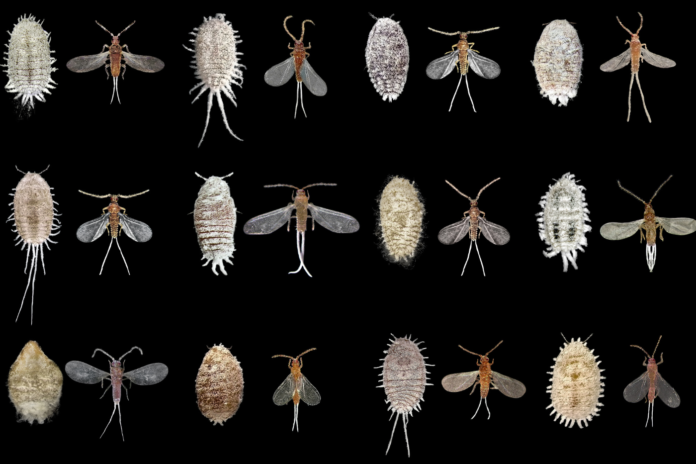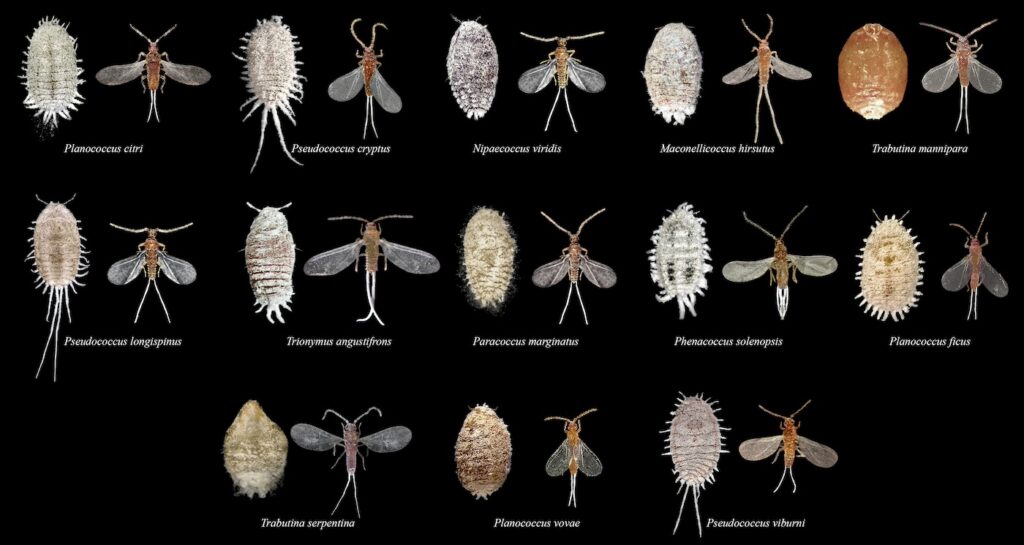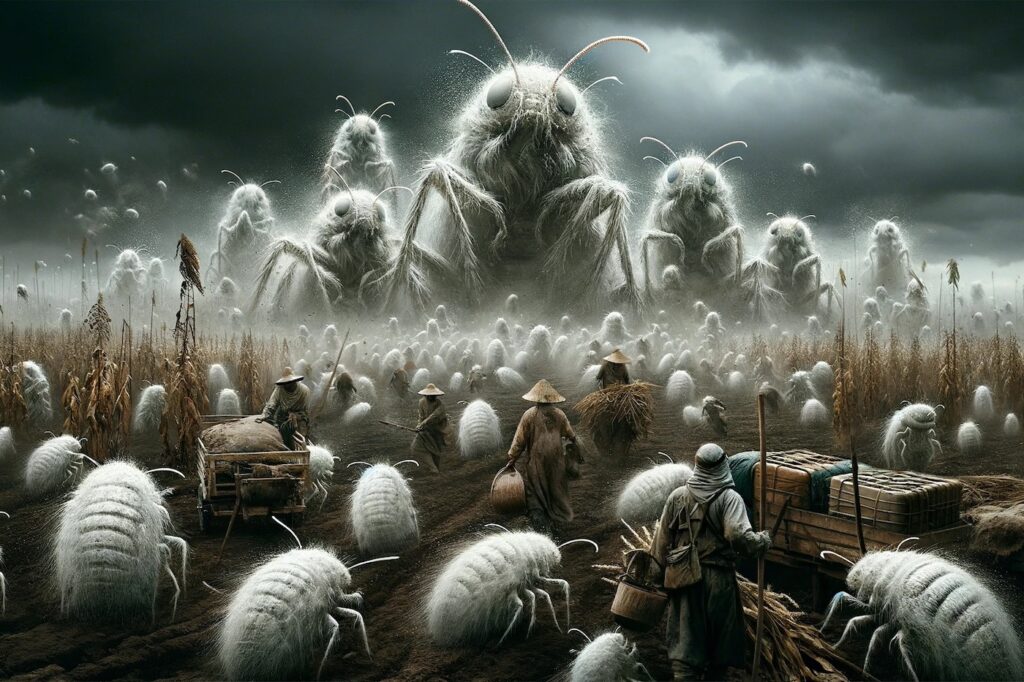
The fight against fungi and pests is a war with no end in sight. Whether it’s aphids, spider mites, fungus, gnats, or mealybugs, there’s always something trying to devour a farmer’s profits for breakfast, lunch, and dinner.
Mealybugs are an especially annoying pest for cannabis cultivators. These insects feed on plant juices from foliage and stems, excreting a sap-like substance. This post-meal residue attracts other unwanted predators, including wasps, ants, and aphids. If not addressed quickly, mealybugs become the harbingers of death.
These little white pests are common in indoor gardens because they thrive in warm, humid climates. However, they’re quite happy to infest outdoor gardens if the environment is inviting. While an ounce of prevention is worth a pound of cure, there are a few ways to stop these bugs in their tracks when they inevitably try to move in.
Identifying mealybugs
Mealybugs are soft-bodied insects commonly found on indoor and outdoor plants. While there’s some variation between different mealybug species, they often appear as white cotton masses resembling pieces of fluff or mold to the untrained eye. Most typically measure between 1/20 and 1/5 of an inch in length or one to five millimeters. Their oval-shaped bodies are covered in a white waxy substance that gives them a powdery appearance.

Upon closer inspection, they’re identifiable by their segmented abdomens and long, thread-like tails protruding from their rear ends. Their short antennae and legs are often difficult to see under the dense covering of wax. When present in large numbers, they can form heavy colonies on the undersides of leaves, along stems, and in the crevices of plants.

Preventive measures
Spotting mealybug infestations early is crucial for effective pest management, as these insects multiply quickly. Regularly inspecting plants, particularly in nooks and crannies where these bugs are known to hide, will help ensure quick detection and prevent infestations from spreading.
- Inspect plants regularly
Perform routine plant inspections, paying close attention to the undersides of leaves, up and down stems, and inside any crevices where mealybugs are likely to hide. Also inspect for signs of mealybug presence, such as white, cottony masses or sticky residue on plants from bug excretions.
- Prune infested plant parts
If you spot any signs of mealybugs during an inspection, promptly prune and remove affected plant parts taking care not to shake any bugs off when pruning. This can help prevent them from spreading to other plants nearby.
- Promote air circulation
Mealybugs thrive in environments with poor air circulation. Increase airflow around your plants by ensuring there’s enough space between growing plants to avoid overcrowding.
- Avoid overwatering
Mealybugs are attracted to stressed and weak plants. Water your plants appropriately based on their specific needs, but always err on the drier side and allow the soil or grow medium to fully dry between watering sessions.
- Keep plants healthy
Healthy plants are more resistant to pest infestations. Provide your plants with proper nutrients through regular fertilization and ensure they receive adequate sunlight.
- Quarantine new plants
Before introducing new plants to your garden or indoor space, inspect them thoroughly for signs of mealybugs or other pests. Consider quarantining new plants to monitor for any signs of infestation before integrating them into a large plant collection.

Natural treatments for mealybugs
Several options exist to eradicate mealybugs, many of which contain all-natural ingredients. However, chemical insecticides may be necessary in extreme cases.
Apple cider vinegar
Apple cider vinegar is a simple yet effective way to mitigate mealybugs. This acidic liquid is often the first line of defense when insects are spotted. Combine one ounce of apple cider vinegar with two to three ounces of water. Apply with a spray bottle later in the day. It’s important to apply anti-pest measures when the sun is low or when lights are about to be switched off to avoid phytotoxicity damaging the plants. When substances are applied to leaves in direct light, the risk of phytotoxicity increases.
Alcohol
Dilute isopropyl alcohol or rubbing alcohol with water (usually in a 1:1 or 1:2 ratio) and spray the solution directly onto mealybugs. This treatment dissolves the insect’s waxy coating, leading to bug dehydration and death. Apply the alcohol solution in the early morning or late afternoon to avoid damaging the plant tissue. It’s always a good idea to test a small area on a plant first to ensure it doesn’t react negatively before spraying more.
Neem oil and soap
For an effective organic control method, mix neem oil (diluted according to the manufacturer’s instructions) with a few drops of liquid dish soap or insecticidal soap in a spray bottle. Spray the neem oil solution onto affected plants, ensuring thorough coverage. Reapply every seven to 14 days until the infestation is under control. Apply in the early morning or late afternoon to avoid burning the plant in direct sunlight.
Beneficial insects
For another natural solution, release beneficial insects such as ladybugs, lacewings, or parasitic wasps near infested plants in the evening. These insects are natural predators that feed on mealybugs and their eggs. Provide habitat and food sources for beneficial insects to encourage them to stay in your garden or indoor space. This varies from bug to bug but typically includes a consistent temperature and humidity, just like the plants in the garden would want.
Chemical treatments
Systemic insecticides play a vital role in long-term protection against mealybugs. These treatments are absorbed by the plant, providing continuous protection against hidden bugs for weeks, if not months at a time. PyGanic makes a chrysanthemum extract blend that is especially useful for infestations. Zero Tolerance from Ed Rosenthal is another preventative measure.
Systemic insecticides target mealybugs when they feed on plant sap and reduce the need for frequent applications of contact insecticides. However, it’s essential to follow the manufacturer’s instructions carefully and consider their impact on beneficial insects and the environment.
Aftercare and monitoring
Monitoring plants post-treatment is crucial to ensure effective control and prevent future outbreaks. Everyone in the grow room can pay attention to plants for signs of mealybug activity, such as white, cottony masses or clusters of insects. After an infestation, pay close attention to plant growth rate and overall health for signs of stress or re-infestation.
Preventing future infestations involves practicing good plant hygiene, quarantining new plants, avoiding overfertilization, and promptly addressing plant stress. These measures minimize susceptibility to mealybugs and other pests.
Mealybugs FAQ
Mealybugs can wreak havoc on cannabis gardens. Here are a few more things to consider.
What do mealy bugs look like?
Mealybugs are tiny, white, cottony insects typically measuring between 1/20 and 1/5 of an inch in length. They have oval-shaped bodies, segmented abdomens, and long thread-like tails covered in a powdery white wax. They often form clusters on plant surfaces.
Will dish soap kill mealybugs?
Yes, dish soap can effectively kill mealybugs by disrupting their protective wax coating and dehydrating them. Mixing a small amount of liquid dish soap with water and spraying it directly onto the bugs is an effective organic method of controlling their population. However, it’s important to use caution and test a small area of the plant first to ensure the soap solution does not harm the plant.
How can I get rid of mealybugs?
The most common treatments for mealybugs are apple cider vinegar, dish soap, neem oil, and rubbing alcohol. Beneficial insects may also be used. However, prevention is always the best way to deal with all bugs in the garden.
What’s the best mealybugs treatment?
Use a mixture with an acidic active ingredient, such as apple cider vinegar or neem oil with a quart of water in a spray bottle. Monitor the garden closely to catch mealybugs on plants before they create bigger infestation problems.
Mealybugs: a nuisance that can be controlled
The scourge of insect infestations is the bane of any grower’s existence, and mealybugs are no exception. The white waxy creatures can devastate crops and often invite even more serious predators such as aphids and ants.
Growers should exercise vigilant plant care to prevent mealybugs from wreaking havoc, deploying preventive measures and close monitoring for little white bugs on plants. Using mitigation methods such as apple cider vinegar solutions or chemical insecticides at the first sign of bugs will help ensure things don’t spiral out of control. If left alone, these problematic pests will spell certain doom for plant yields and profits.
